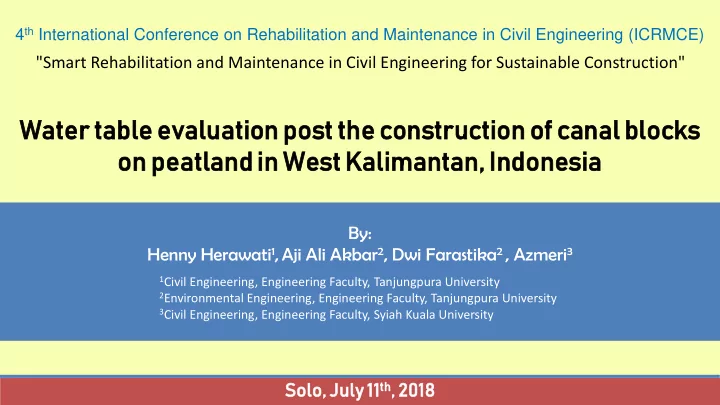

4 th International Conference on Rehabilitation and Maintenance in Civil Engineering (ICRMCE) "Smart Rehabilitation and Maintenance in Civil Engineering for Sustainable Construction" Water Wa ter ta table ble eval aluati uation on pos ost t th the con onstruction struction of of can anal al blocks ocks on on peatland atland in in We West st Ka Kalimantan, imantan, In Indones onesia ia By: Henny Herawati 1 , Aji Ali Akbar 2 , Dwi Farastika 2 , Azmeri 3 1 Civil Engineering, Engineering Faculty, Tanjungpura University 2 Environmental Engineering, Engineering Faculty, Tanjungpura University 3 Civil Engineering, Engineering Faculty, Syiah Kuala University Solo, , July y 11 th th , , 20 2018
BACKGROUND • To start agricultural practices in wetlands: dry the wetlands • Started by Bugis and Malay with limited Indonesia’s Peat capacity in 1960’s Restoration Agency • in line with transmigration and food self- (BRG-RI) suffiency program in 1970’s • is used as a clear regional boundaries The construction The creation of of canal blocks canal network • Water flow out easily through canals • Excessive drainage in dry season • Loss of peatland’s ability to store water • Decline in water table In peatland • Land subsidence, release of greenhouse gasses, peat fires. Objective: To asses and evaluate changes of water table in peatland
WATER MANAGEMENT ON PEATLAND TheImpacts: Possible mechanisms: Retain critical water level in dry season Blocking the canal on peatland Prevent flooding during rainy season Building sluice gates on peatlands The Requirements: Creating pond as a water reservoir on peatlands Establishing long storage on existing canals Maintain the water level at the relevant in peatlands by installing canal blocks. level, typically less than 40 cm
STUDY AREA Wajok Hilir Village • has long been endeavored by most local communities as agricultural land • has high rainfall potential Indonesia • is affected by tides • is not supposed to experience drought • is one of the target villages of Indonesia’s Peatland Restoration Agency • has several canal blocks built in 2017 Orientation of Wajok Hilir Village in West Kalimantan Province
STUDY AREA Construction of canal block in Wajok Hilir Village, Documentation on January, 2018
METHODOLOGY Data collection Observation Sampling points method time Compared area where canal Indonesia Every day in a month at block is built and surrounding Consider periodic 06.00 a.m. and at 06.00 areas where canal block is time of the tides p.m. not built. reading the water level Compared location around elevation on a peil from Feb to March tertiary canal with location scale/piezometer on 2018 around quaternary canal peatland
RESULTS Average water table at observation point(cm) Observation Point Item 1 2 3 4 1 : land around quaternary blocked canal max 73,3 69,5 79,5 77,8 2 : land around quaternary non-blocked canal 3 : tertiary canal non-blocked canal min 45,5 14,5 45 22,5 4 : land around tertiary non-blocked canal interval 27,8 55,0 34,5 55,3 • water fluctuation : land surrounding blocked canal (1 = 27,8 cm) << around non-blocked canal (2 = 55,0 cm) ➢ Canal block helps retain water table longer + tidal effect is now capable of injecting groundwater into lands • Decline in water table : Tertiary (4 = 77,8 cm and 22,5 cm) >> Quaternary canal (2 = 69,5 cm and 14,5 cm) ➢ Dimensions : Tertiary >> Quaternary canal → Large canal dimensions being able to carry more water out of the land
DISCUSSIONS Water table tend to be far deep below the ground in dry season PREVIOUS STUDIES Water table Water table on Minimize <50 cm Research by Fitriati, et. al, 2017 peatlands is potential reduce important to for land ➢ Canal blocking can increase water content of peat soil↓ dryness of maintain fires Non-blocked canal area → water content ± 60% the peat Blocked canal area → water content ± 250%. Research by Lundin, et. al, 2017 ➢ 2 previously degraded hydrological function of peat Field measurements have shown that water tables in returned to natural / semi-natural condition after peatlands around blocked canals have an average subjected to peatland rewetting for 15 years water table of <50 cm Research by Grand-Clement, et. al, 2015 Canal block may also be a water retainer in the canal → ➢ The construction of canal block is proven to reduce canal serves as water container in the form of long carbon release and increase biodiversity. storage
CONCLUSION AND RECOMMENDATION After the construction of canal blocks → decline in water table in peatlands can be maintained Indonesia Canal blocks may also be utilized to retain water in the canal → making a water reservoir in the canal that serves as a long storage → to meet the water needs for irrigation in area surrounding the canal Recommendation: to control water table in peatlands ↓ Construct canal blocks on tertiary and quaternary canals for all locations on peatlands.
Thank You….
Recommend
More recommend